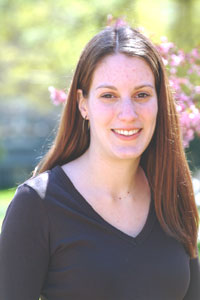PHYSICS LESSONS

Details
When graduating Haverford senior Amy Perlman, a physics major, stepped on stage at the Los Angeles Convention Center before 6,500 experts last March, she admitted to "feeling a little nervous." Not too many undergrads speak before the august American Physical Society, and Dr. Phaedon Avouris, Columbia University adjunct chemistry professor was in the house to hear her presentation, "Electrical Breakdown of Carbon Nanotubes in Ultrahigh Vacuum": "Well, he's the God of carbon nanotubes, that's all," Amy recalls. "What he says goes, and he'd just grilled the guy before me ..."
But Avouris didn't grill Amy. "He asked some questions, along with the others, but they were in the spirit of being helpful." Like: "Did you try baking the sample?" — a necessary step in experiments aimed at relaxing the carbon nanotubes on the way to "breaking" them — Perlman's research, under Professor Walter Smith, her thesis and research adviser, was in ways to make carbon nanotubes, already more efficient than copper wire as conductors of electronic impulses, even more so. The idea is to study the "breaks" more minutely, enabling researchers to learn more about how fundamental connections work... (Nanotubes are extremely thin, hollow cylinders 10,000 times smaller than a human hair. They can be used in nano-electronic devices, such as computers.)
"It was one of the great things about being at a place like Haverford," Amy says."I got to do research [and do the APS talk], opportunities that might have gone to graduate students [at a larger school]. "What was remarkable about being here was the warmth and spirit of cooperation" — of collegial attitudes to problem-solving and [moving forward in science]. "We often gathered in the beautiful lounge — we're a relatively small department — and just worked on stuff one of us was doing."
"Amy's right that the research opportunities available to undergraduates at Haverford are unusual, though they're far from unique," Professor Smith clarifies. "Haverford was a pioneer institution in performing cutting-edge research with undergrads...[but] at this point there are many places that do this well...Haverford still emphasizes it more strongly...[Also] it's not uncommon for Haverford students to give talks at national meetings...several of our students [counting all the sciences] do this each year," but it's true that only about one physics student does so a year.
"One thing that is unusual about Amy is the degree to which she took advantage of the opportunities available...In addition to her research work, she has been tutoring in a South Philadelphia school for a few years...I think it's the combination of her dedication to teaching, as shown by her consistent efforts in tutoring underprivileged students; the breadth of her coursework in physics, math, and education; and her research, which together made her a strong candidate for the Knowles."
Perlman has been tutoring other students since her days at George Mason High School in Falls Church, Virginia, so her orientation has always been toward teaching: "It sounds kind of cheesy to say this, but some people don't want to be teachers — something you do for others...But I loved my high school physics class. It was part of the real world, empowering...like I saw that you could be walking down the street, watching the motion of cars passing, and you could explain big things by just observing the everyday things around you...So I see myself teaching in places where you can seed that..."
She's not yet sure whether she'll be a full-time student in a graduate program this fall, or will be teaching part-time in a high school near her home. The dispersal of monies from the Knowles will depend on which course of action she takes. The fellowship provides $10,000 a year for two years for tuition assistance in a certification or master's program; a $1,000-a-month stipend if she chooses to be a full-time student; and professional development activities, mentoring, and classroom grants. The classroom support is renewable up to five years.
"One thing about teaching in high schools, too, is that you can encourage females to go into fields like physics," Amy emphasizes. "I wasn't encouraged — I was just stubborn. And I was the only female physics major [in my class] at Haverford."
Learn more about the Knowles Teaching Fellowships here.



